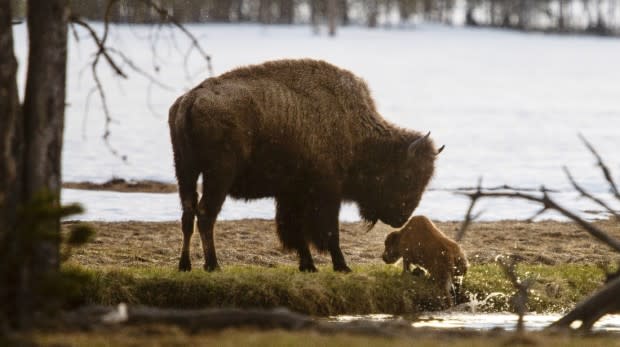Yellowstone Was Forced to Euthanize a Bison Calf After a Visitor Picked It Up, Causing the Herd to Reject It

There's a reason National Parks require visitors to keep a distance from wildlife, if not for their own safety then for the safety of animals. Yellowstone National Park had to put down a bison calf this week after a man picked it up, resulting in the herd rejecting the baby animal.
Park officials are looking for an unidentified man in his 40s or 50s who approached a newborn bison calf in Lamar Valley on May 20, near the junction of the Lamar River and Soda Butte Creek. After being separated from its mother when the herd crossed the river, the man—perhaps thinking he was doing a good deed—pushed the struggling calf up the river bank near the road.
Unfortunately, after being "rescued," the calf was then seen following people and cars, putting both itself and visitors in jeopardy. And when repeated efforts by park rangers to reunite the calf with the herd failed, it ultimately had to be euthanized.
In a statement on Twitter, Yellowstone responded to an outcry from people wondering why another measure hadn't been taken, such as sending the calf to a sanctuary.
However, transporting bison out of Yellowstone is strictly forbidden by state and federal regulations unless the animal is going to meat processing or scientific research facilities. And while the park does have a quarantine facility where bison can go through months-long brucellosis testing protocols and subsequently be placed in conservation herds elsewhere, the young age of the calf made it an unlikely candidate since it was unable to care for itself.
"It's important to understand that national parks are very different than animal sanctuaries or zoos," the statement read. "We made the choice we did not because we are lazy, uncaring, or inexpert in our understanding of bison biology. We made the choice we did because national parks preserve natural processes."
The statement went on to point out that the cycle of life for undomesticated wildlife is crucial to the park ecosystem.
"Every day in national parks, some animals die so that others may live," the statement continued. "In fact, as many as 25 percent of the bison calves born this spring will die, but those deaths will benefit other animals by feeding everything from bears and wolves to birds and insects." It added that the calf's body was left on the grounds as it would have been had it died a natural death.
Although guidelines differ among National Parks, many parks require visitors to keep a minimum distance of 25 yards from most wildlife, and 100 yards from predators such as bears and wolves.
